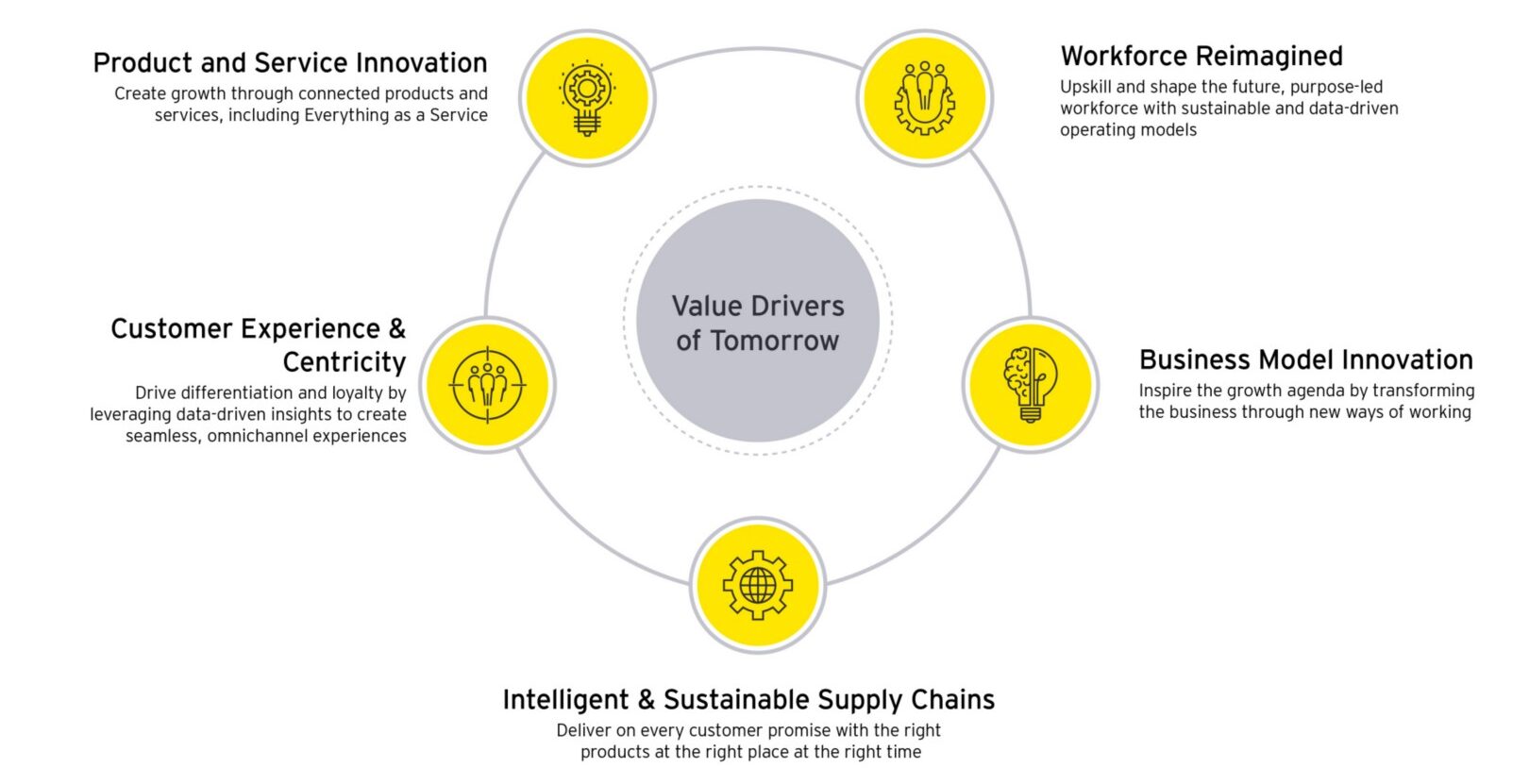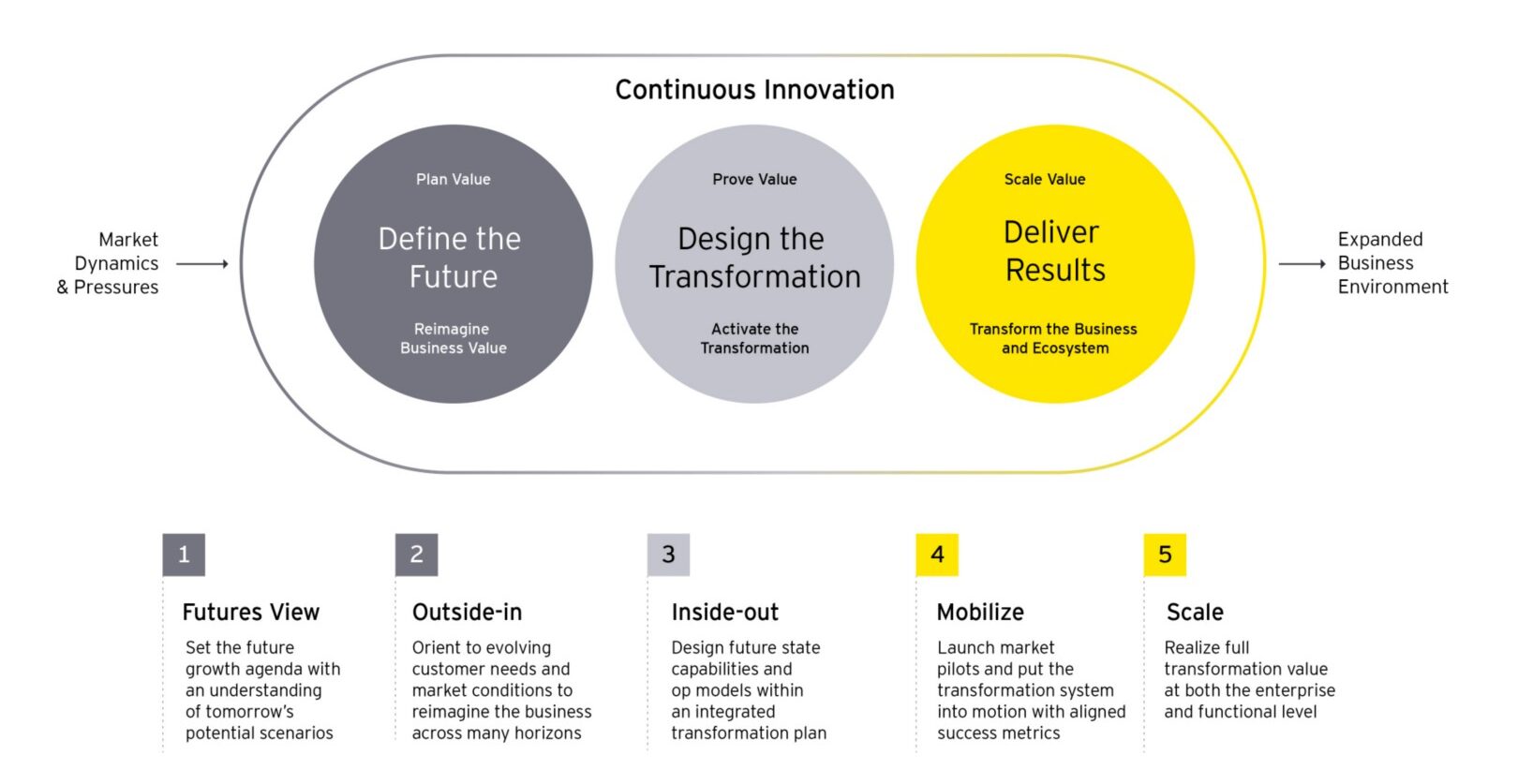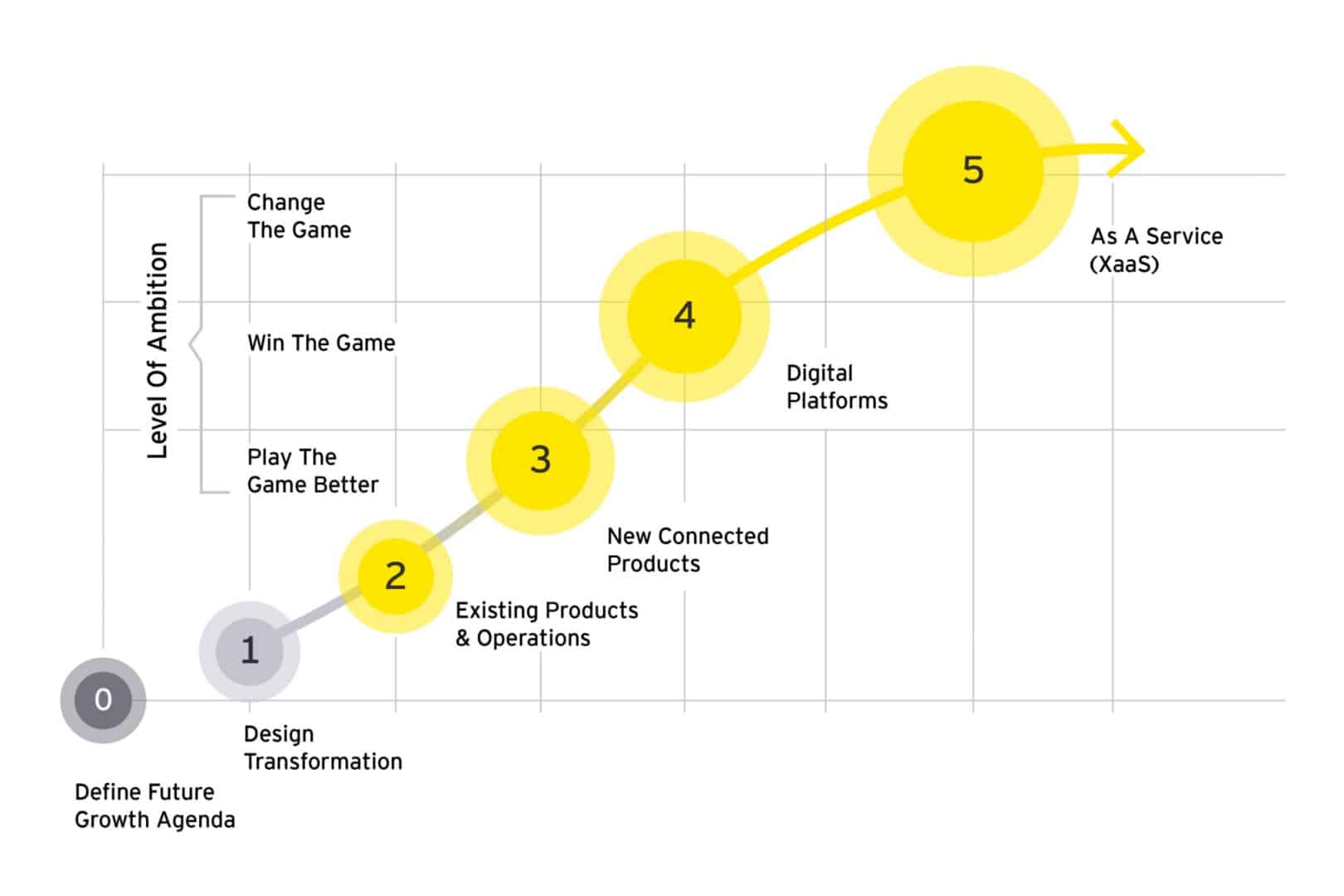Placing Innovation at the Heart of Transformation

To build the right foundation for long-term growth, manufacturers must put innovation and digital strategies at the heart of transformation.

TAKEAWAYS:
● Massive geopolitical, technological and cultural changes have prompted unprecedented shifts in industrial manufacturing.
● As pressures mount to build smart products, digitize operations and exceed customer expectations, incremental approaches to change are falling short.
● Manufacturers need to design a transformation that is innovative, agile, cross-functional, and scalable to realize tangible business value.
Over the last several years, challenges related to geopolitics, technology, the pandemic and climate change have shaken the foundation of industrial manufacturing – creating tectonic shifts in how manufacturers think, operate and deliver their products and services.
The pressure to make products smart and connected, digitize the factory and operations, create more automated and reliable supply chains, and deliver on rising customer expectations presents significant opportunities to move toward radical growth. Yet many manufacturers’ current approaches – driven by siloed teams, functions rather than strategies, and static views of competitive and operational landscapes – present significant risks on the road to reinvention.
Legacy manufacturers trying to speed ahead into the future of smart products, digital platforms and new service-oriented business models urgently need a better way forward. A hybrid, innovation-led approach that incubates future businesses while simultaneously optimizing today’s products and operations can provide practical, value-driven solutions in both the short and long term.
Disruptive Forces Shift Operational Priorities
The range of disruptive forces manufacturers are experiencing has implications across the entire enterprise. These forces include:
- sector convergence
- power shifts within value chains
- evolving customer expectations
- volatile macroeconomic environments
- tougher workforce dynamics
- sustainability pressures
- transformative technologies
In response, manufacturers are prioritizing digital transformation and innovation-related investments. According to the EY January 2023 CEO Outlook Pulse survey, virtually all (97%) of industrial manufacturing CEOs indicated that continuing digital and technology transformation to deliver growth and operational advantages is either a very or fairly important near-term priority, despite near-term economic uncertainty.
Through these investments, manufacturers seek to revolutionize processes by implementing innovations such as digital twins, artificial intelligence and machine learning. At the same time, they are advancing product and service offerings across the value chain that are smart and connected.
However, to fully realize the significant opportunities arising from disruption and the value of these investments, manufacturers must tie them to a unifying vision of where their markets are headed.

“Legacy manufacturers trying to speed ahead into the future of smart products, digital platforms and new service-oriented business models urgently need a better way forward”
A Different, Innovation-Focused Approach to Manufacturing Transformation
Forging a new path to the future will require manufacturers to put their growth agenda at the center of transformation. This plan needs to be backed by a detailed strategic roadmap that accounts for both the innovations needed to succeed and the transformation required to launch and scale these breakthroughs in the market. It must also be developed with an enterprise-wide outcome in mind, breaking down functional and geographic silos.
While not every initiative needs extensive cross-organizational coordination and buy-in, many of the most prominent areas for manufacturers’ business reinvention are inherently interdisciplinary. Effective transformations demand engagement with a range of intersecting value drivers, including product and service innovation; customer experience; intelligent and sustainable supply chains; workforce and talent; and business model innovation.
Image 1: The value drivers of tomorrow

Image 1: A chart showing the value drivers of tomorrow that intersect include product and service innovation; customer experience; intelligent and sustainable supply chains; workforce and talent; and business model innovation. Source: EY
Once a decision is made to pursue small- or large-scale reinvention, manufacturers can maximize the speed, agility and long-term value generation by adopting the following best practices.
Start With the End in Mind But Also Know Where to Begin
With business challenges clearly defined, manufacturers should explore solutions using a future-back approach that starts with the end in mind. The critical first step involves rapidly defining and assessing tomorrow’s potential futures from the outside-in, and predicting how these future scenarios may shape customer needs, market conditions and value pools across time horizons. In parallel, organizations must also perform a thorough review of their current capabilities, particularly those that may play an increasingly important role in future competitiveness.
Taken together, assessments of a company’s current state and potential futures serve as the foundation of a new strategy that will act as the transformation’s North Star – guiding it relative to the level of ambition, while optimizing development speed and investment spending. This strategy should also provide a framework for cross-enterprise transparency and engagement.
Image 2: Our approach to transformation

Image 2: A chart showing the continuous innovation process which defines the future growth agenda, designs the transformation plan to deliver results both at the enterprise and functional level. Source: EY
Design the Transformation With a Hands-On Approach to Innovation
Rapid prototyping is an essential step for manufacturers to substantiate their future views and refine perspectives on must-have innovations. Multiple, accelerated iterations of both physical products and digital offerings are important for assessing features and costs in the context of various customer expectations, demand levels and competition scenarios.
Making the future tangible will pay dividends in the design phase of the transformation. Understanding necessary enterprise-wide adaptations – from specific technology or talent enhancements to new business models – will inform an achievable, cross-functional plan. The ability to “show your work” will also help build support across various internal constituencies as they are enlisted in the effort.
Start with the end in mind

Image 3: A chart showing the continuous innovation process which defines the future growth agenda, designs the transformation plan, analyzes existing products and operations, connects new products, embeds digital platforms to redesign As-A-Service (XaaS). Source: EY
Accelerate Results By Incubating New Business Model Concepts
When future growth depends on technologies, customer expectations or new value pools that are not addressed by a manufacturer’s current core competencies, innovation at the business model level may be a solution. For example, what are the implications of collecting, analyzing and monetizing data from a new connected product? Successfully assessing and addressing these impacts could enable manufacturers to leapfrog the competition.

“To fully realize the significant opportunities arising from disruption and the value of these investments, manufacturers must tie them to a unifying vision of where their markets are headed”
Given the enterprise-wide implications of such changes, legacy manufacturers should prioritize small-scale experimentation with a lean, internal start-up style approach. In conjunction with ongoing physical product innovation, manufacturers will want to invest in teams to explore the internal and external infrastructure and capabilities needed to support an operating model for an offering’s full lifecycle. This approach can be particularly beneficial for evaluating the technology infrastructure required for a potential new business model. By using focused, lean teams, manufacturers can leverage agile sprints to further define capabilities and architectural requirements as the transformation progresses.
Identify Ecosystem Partners to Address Critical Capability Gaps
As manufacturers innovate, they will have to decide whether their long-term strategies are better served by seeking ecosystem partners versus internally developing or acquiring new capabilities. Assessing targeted value pools and key differentiators of success can help inform these decisions.
Manufacturers whose future offerings are likely to depend on the secure sharing and analysis of data at scale will want to consider partnering with technology providers as a more efficient path to market. However, the factors to consider when choosing a mission-critical partner can be extensive, particularly given the high cost of potential failure. Legacy manufacturers can benefit from a structured process to weigh the benefits of various collaborators.
Manufacturers exploring business model innovation may also find a need for ecosystem partners outside of the technology sector. For example, future mobility business models may involve close collaboration among vehicle OEMs, energy, infrastructure and insurance firms.
Key Questions For Manufacturers Considering Reinvention
The urgency around transformation has escalated as manufacturers grapple with multi-faceted disruptions. Reactive, short-term focused responses limit the vision for enterprise-wide transformation. When thinking about the right approach, manufacturers should consider the following questions:
- Product and service innovation: How do we evolve our product portfolio to create dynamic products and services that address customer demands for smarter and more connected features, customization, and safety/security?
- Customer experience: How does a shift from B2B to B2C or D2C impact how we operate today?
- Operations:
a. How can we leverage emerging technologies to future-proof our supply chain?
b. How do we design our future manufacturing capabilities as a competitive differentiator? - Workforce and talent: How can we advance innovation as a core capability through hiring, developing, training and incentivizing our employees?
- Business model innovation: How do we innovate to drive the core business to peak profitability while simultaneously incubating new growth engines?
Answers to these questions may help leaders address strategic or operational gaps. With a clear vision of their organization’s future ambitions in mind, and a strong strategy for innovation-focused transformation, leaders can position their organizations to accelerate growth and leapfrog their competition. M
About the Authors:

David Takeuchi is EY’s Global Strategy and Transformation Business Model Innovation Leader

Jerry Gootee is EY’s Global Advanced Manufacturing Sector Leader

Claudio Knizek is EY-Parthenon’s Global Advanced Manufacturing and Mobility Leader